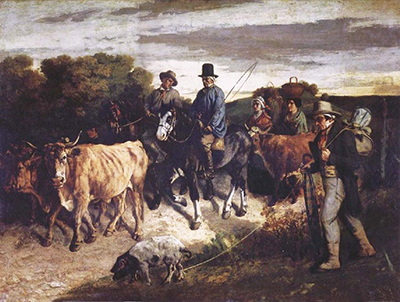The Peasants of Flagey continues Courbet's love affair with his native region of Ornans and the surrounding areas. Again, he desires to promote the qualities of the rural communities, even though it was proving a hard-sell to the critical Parisians of that age.
Courbet's honest, accurate depictions of rural life was deemed ugly by many. But he felt a love and affection for this community which needed no amendment for the sake of traditional art tastes. Those featured in this painting are believed to be the farmers of the Doubs who owned land themselves and went to fairs in order to trade livestock. They lived in close contact with their animals but this lifestyle confused city-dwellers. Some even claimed that this painting alone could dispel their affections for the French countryside. Courbet would not normally listen to such people, only occasionally taking their opinions in mind when adapting work to gain Salon acceptance.
Courbet's use of realism would inspire later generations of European artists but it was actually abroad that he received more support for his work. Whilst some pockets of the French art community did offer him support, it was actually it travels to Germany that first helped him to realise that his work would eventually be loved within the mainstream. He led a collection of realist artists and these developments would help bring about later creative groups such as the French Impressionists. Without his creativity and pig-headed belief in what he was doing, artists such as Monet, Bazille and Caillebotte may never have come about.
This artwork was of particular importance to Courbet who decided several years later to re-visit elements of the composition and move one of the figures to the other side of the canvas. He did similar to other paintings and the longest gap between his initial work and later amendments right across his career was actually a full decade. In some cases these amendments have been uncovered through scientific means, whilst other times there have been study sketches that have appeared, detailing how elements were intially put together.




